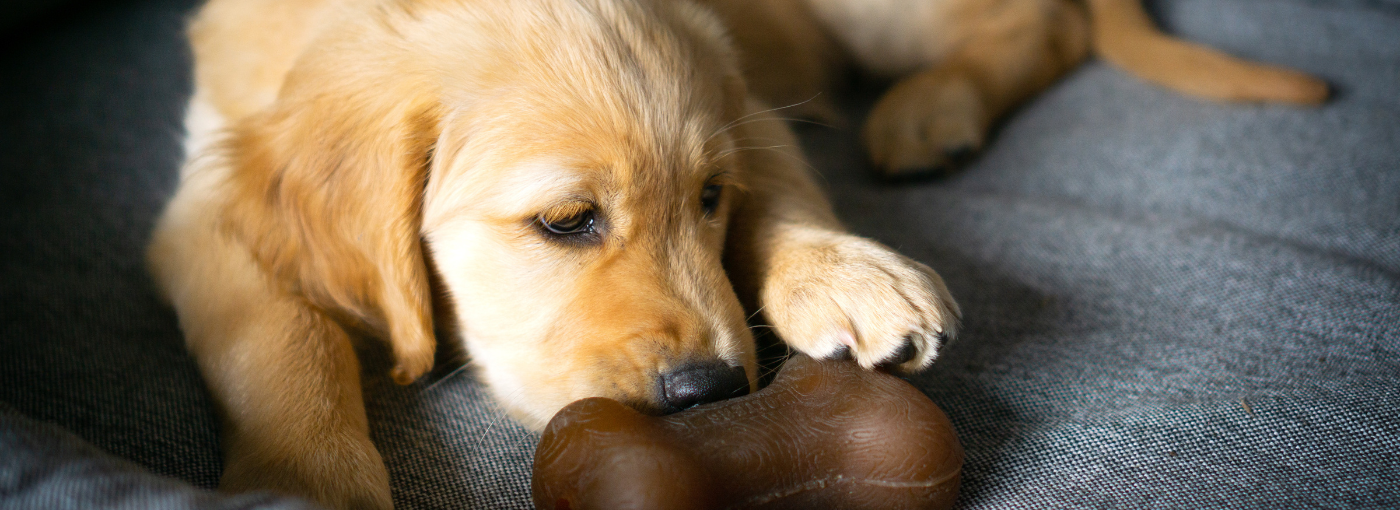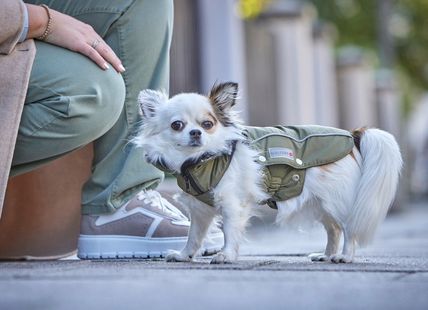
Basic Equipment for Puppies
In October, little Nuri moved into our home. She's an active and curious golden retriever puppy. And even though I already have all the necessary equipment at home because of my first dog Laika, I nonetheless wondered, "What do I really need for a puppy?"
With the bewildering variety of dog equipment on offer, it's easy to lose sight of what's really important. Therefore, this article will give you an overview about the basic equipment you and your puppy need.
A suitable place to sleep
Of course, a puppy needs more than one place to sleep. Ideally, these are located in the rooms of the house, where you spent the most time. In our home, these rooms are the bedroom, the living room and the office. A puppy does not necessarily need a big bed yet. However, they should be able to comfortable stretch out and lay down in bed. For Nuri, we're currently using the Dream-Well Hope dog bed in the colour grey and the size L. She enjoys relaxing in the bed and leaning against the high side walls. Furthermore, the high side walls also protect her against cold air and drafts. One huge advantage: The covers maybe completely removed and washed at 30 degrees Celsius.
.jpg)
Food bowls
Of course, food bowls are also necessary. We prefer bowls made from ceramics. Ceramic bowls do not slip easily and they don't contain synthetic substances which might get into the water or food. What is more, they're also easy to clean in the dishwasher. We are using the Wolters Diner Stone food bowls every day. The glazing is heavy-metal-free and food-safe. Furthermore, the bowls are minimalistic and the natural stone look perfectly matches any interior design style.
.png)
Harness, collar, leash and towing leash
For a puppy, a harness is preferable, because jump dogs tend to jump or tug on the leash. In order to prevent injuries to the cervical vertebrae, a harness is the ideal choice. We have chosen the Professional Harness because due to its infinite adjustability, it literally grows along with the puppy. Nuri wears size M in the colour rust-red. With this harness, you can adjust the size of the chest strap as well as the belly strap and even the midriff. The harness is equipped with quick release fasteners, so you can easily put it on your puppy and take it off again. The most important thing for me is this: In addition to its good fit, the harness is very lightweight. When moving in, your new puppy usually knows neither collar nor harness. Therefore, it's very important that the harness is neither too heavy nor wide.

Of course, there's also a leash to match Nuri's harness. Hereby, I have chosen the Professional Comfort series. These leashes consist not only of the actual leash, but also has a soft neoprene padding. The leash is very comfortable to hold in your hand and it's also adjustable. Nuri's collar is also from the Professional Comfort series. We don't use the collar a lot, but I do use it for training. I want Nuri to learn that when she wears the collar, she is supposed to walk right next to you on a loose leash. When she is wearing the harness, she has more freedom and may also run ahead and sniff.
Finally for me, a towing leash is also a necessary part of your puppy's equipment. There will always be times, when the call-back doesn't quite work so well. In order to secure your puppy, I would advise using a 5-10 meter towing leash such as the Avanti Towing leash offered by WOLTERS.
Chew toys
At the age of four months, a puppy's second teeth come in. Then at the latest, chew toys are crucial, because otherwise a table or chair leg could easily fall victim to the puppy teeth. For chew toys, I prefer natural materials such as chew sticks, natural rubber or organic cotton. The Olivi Bone by WOLTERS is chewed over almost every day in our home. Nuri isn't the only one who loves this chew toy, but Laika also enjoys chewing on the Olivi Bone. The bone consist of 100% natural olive wood, does not splinter and is free of toxic and hazardous substances. Furthermore, the Olivi Bone gently cleans the teeth and the tannins in the wood have an antibacterial effect.
.png)
.png)
.png)
If you prefer natural rubber, the Pure Nature Toy Bone is the perfect choice. Nuri loves this toy as well. It uses no artificial dyes, which means that it's natural, not harmful and environmentally friendly. However, please that you should not leave your dog alone with any chew toys.
.png)
.png)
.png)
Food, treats and chewing products
Regarding food, during the first few days, I'd recommend giving your puppy the food they got at the breeder. A change of food may cause diarrhoea. And it would not be good, if your puppy suffers stomach problems in addition to the stress caused by the move. Otherwise, every dog owner needs to decide for themselves what to feed their dog. When feeding dry food, make sure that it is free of grain. In general, the food should be clearly labelled with regard to ingredients, allergens, etc…
Treats should also be part of your basic supplies. However, you don't need to buy a lot of them. No puppy is born demanding and begging for treats. Most dogs are also happy, if you give them their regular dry food as a reward. Treats should be saved for special occasions and achievements (such as a good call-back, for example). I recommend choosing natural treats such as the meat strips made from 100% air-dried natural meat by Lucky-Pet. In addition to chew toys, you can occasionally also give your puppy a chew product such as pizzle or dried chicken necks.
Treat bags and poo bags
A treat bag is recommended for training or dog school. The practical Neoprino Wonder Bag or the Snackbag Wonder bag by Wolters protects your training snacks against both the weather and curious dog noses. The elastic drawstring allows for quickly taking out a snack, even when the bag is closed. I particularly like the clip on the treat bag, which allows me to easily attach the treat bag to my belt or my handbag.
For your daily walk, you should always have poo bags at hand. The Wolters Webshop will have plenty on offer.
Transport by car
Furthermore, you also need to consider how to transport your puppy in your car. There are various possibilities. Whether you choose a fabric box, aluminium box, a trunk barrier or whether you strap your dog into the backseat, your dog must be secured in the car, otherwise it might be dangerous for both humans and dogs.
In order to make a car ride not just safe but also comfortable for my dogs, I like using the Cleankeeper Travel Pad. This practical mat is comfortably padded and absorbs water and dirt after our daily walks due to the many microfibre strands.
Important To-Dos
Finally, there are some other important To Dos:
- You need to register your dog with the tax or other local authority. This can be done at your municipal administration.
- You should also get a vaccination appointment at the vet.
- Furthermore, it is advisable to register your dog at the pet register Tasso, so that the dog can be reunited with their owner, if they run away and is found by someone.
- Finally, do not neglect liability insurance (which is required in some German states). With young dogs, damages and injuries can easily happen and that way, you and your dog are on the same side.
We hope that this article has given you an overview about the most important supplies you need, when a puppy moves in. In general, a puppy doesn't need a lot of stuff to be happy. But what they definitely need is a lot of understanding, empathy and love.

 Dog collars
Dog collars
 Dog leashes
Dog leashes
 Dog harnesses
Dog harnesses
 Dog clothing
Dog clothing
 Dog beds
Dog beds
 Dog toys
Dog toys
 Care & hygiene
Care & hygiene
 Traveling
Traveling
 Dog bowls
Dog bowls
 Dog food
Dog food
 Dog treats
Dog treats
 Rukka Pets
Rukka Pets

 Winter clothing
Winter clothing
 Rain Clothing
Rain Clothing
 Autumn clothing
Autumn clothing
 Dog sweaters
Dog sweaters
 Clothing for Pug, Bulldogs & Co.
Clothing for Pug, Bulldogs & Co.
 Clothing for Dachshunds
Clothing for Dachshunds

